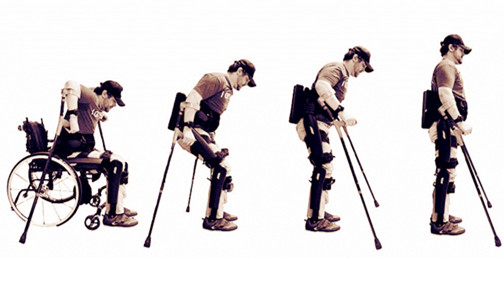NIH develops robotic exoskeleton to treat crouch gait in children
August 30, 2017
Source: medicaldevice-network
 1,171
1,171

A robotic exoskeleton for the treatment of crouch (or flexed-knee) gait in children with cerebral palsy has been developed by US researchers from the Rehabilitation Medicine department of the NIH Clinical Centre.
Crouch gait is an excessive bending of the knees during walking and results in the progressive degeneration of the walking function. The new robotic exoskeleton device is intended to provide powered knee extension assistance at key points during the walking cycle.
The researchers tested the prototype of the exoskeleton in a study of seven children aged 5-19 years who were diagnosed with crouch gait from cerebral palsy and could walk a minimum of 30ft without the use of a walking aid.
Aimed at assessing the role of motorised knee extension assistance in safely and effectively minimising the disorder, the cohort study investigated the device’s effect on voluntary muscle activity during walking.
The study was also designed to quantify short-term alterations in lower limb gait biomechanics with the use of robotic knee extension assistance.
"The improvements in their walking, along with their preserved muscle activity, make us optimistic that our approach could train a new walking pattern in these children."
The results indicated that the exoskeleton was well-tolerated and all participants were able to walk independently without mobility aids or assistance from a therapist.
The study showed that six patients experienced knee extension improvements without a decrease in knee extensor muscle activity, with gains similar to or higher than average observed during invasive surgical interventions.
NIH Clinical Centre Rehabilitation Medicine department staff scientist Thomas Bulea said: “The improvements in their walking, along with their preserved muscle activity, make us optimistic that our approach could train a new walking pattern in these children if deployed over an extended time.
“This study paves the way for the exoskeleton's use outside the clinic setting, greatly increasing the amount and intensity of gait training, which we believe is key to successful long-term outcomes in this population."
By DduRead more on
- Things to Know before Buying Newborn Baby Incubators March 31, 2022
- Highly Resistant Food Poisoning Bug Responds to Antibiotics September 6, 2018
- Smartphone Based Diagnosis to Identify Mosquitoes Transmitting Infection September 5, 2018
- 3 Natural Plant Extracts Manufacturers on Drugdu.com September 4, 2018
- Shenzhen Chuanggan – Health Assessment Facility Supplier September 4, 2018
your submission has already been received.
OK
Subscribe
Please enter a valid Email address!
Submit
The most relevant industry news & insight will be sent to you every two weeks.



